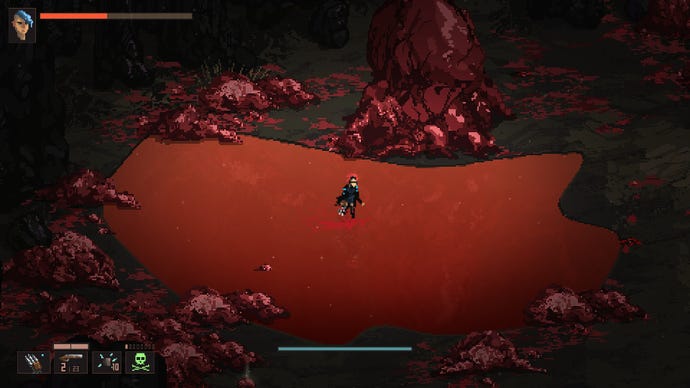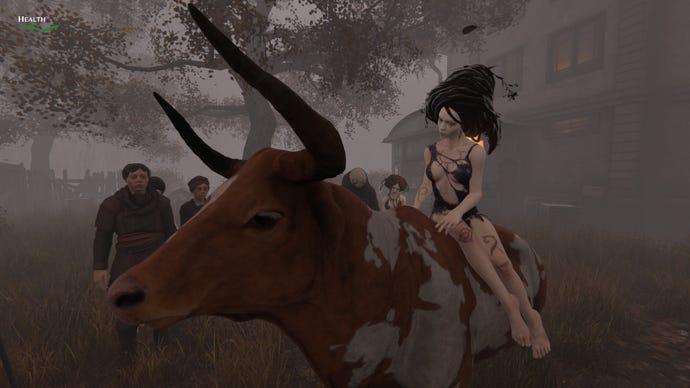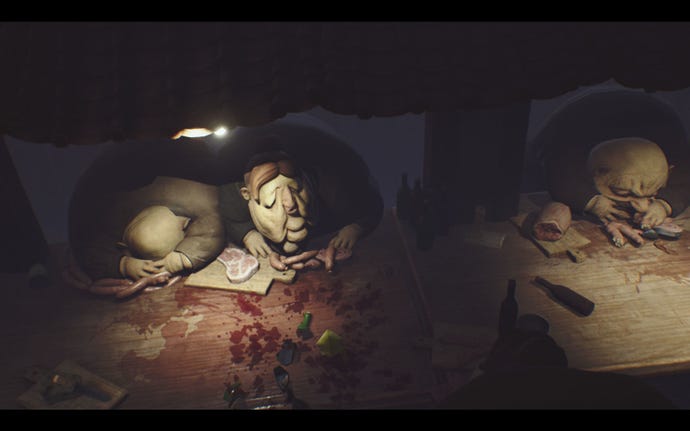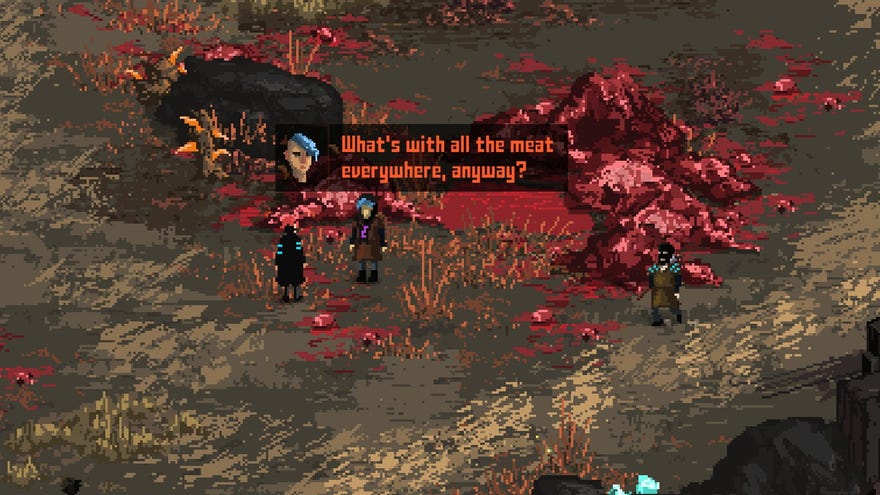Death Trash and others want to know how the sausage is made
The floor is meat
“What’s with all the meat everywhere, anyway?” my Death Trash alter ego Mildred asks. “It’s just there. Grows.” the meat merchant replies. “Maybe we’re living on a planet full of flesh and right now we’re standing on a crust of stone and dirt. So, do you want a piece of meat now?” I really don’t. But Mildred does. After all, this mystery meat is the main healing item in the game. It’s what keeps you and the world around you alive. It’s harvested from the ground like precious stones, the literal blood flowing in this grotesque world’s barebones economy, eaten raw and served in meat bars.
But where does the meat come from? Whence the amorphous flesh blobs and pools of blood? From another planet, another dimension? There are no animals in this strange ecosystem apart from Fleshworms. The strange meat seems to be linked to another mystery, the advent of the flesh titans (which are exactly what the name suggests). Soon we discover that we are able to commune with the meat and, through it, speak to a enigmatic being called The Oracle. The meat is a kind of universal consciousness, a flesh and blood information highway, into which those who are attuned to it can plug in. Whether the meat and the flesh titans are good or bad for humanity is up for debate, and there are factions that deify and others that hate them, vying for power. The clot thickens.

Death Trash isn’t the only game where mysterious meat, supercharged with strange powers and properties, dominates the world. The indie horror game Carrion is another example in which an amorphous growth of meat takes over and creates a world in its image. In it, we play as an ever-growing toothy biomass that devours meat (mostly in the form of people) to become ever more massive.
Bit by gristly bit, sterile corridors are turned into fleshy, pulsating meat tunnels. Where did the meat monster come from? All we know for sure is that it escaped from some secret lab where illicit experiments were conducted far from the public eye; until, that is, it escapes into the city to flood the entire world with its dubious meat.

Pathologic 2 is a bit more subtle, but just as in Death Trash and Carrion, meat is the tissue that holds its world together. “Every path leads to meat. Nothing is more filling,” the game says. Here, meat constitutes not only a meal, but also meaning: it’s a metaphor that makes sense of the world. Meat and its production are not only the foundation on which the town’s economy and livelihoods rely on, it also carries with it spiritual and even cosmological weight. To the Kin, the Steppe’s indigenous people, every single body of flesh and blood is a small image of the cosmos as a whole. The violation and cutting of flesh, whether for the purpose of slaughter or healing, whether animal or human, is taboo except if performed by special casts of people adhering by strict rules.
The same is true even for digging in the ground, which is seen as the flesh of the Earth. The whole town and the ground on which it is built becomes a gigantic metaphor for a universal, cosmological body, with districts named after anatomical parts like Backbone, Gut, Marrow and Hindquarters. The Abattoir, a temple turned slaughterhouse in the outskirts, is in many ways the heart of the town but is also paradoxically hidden from sight and inaccessible for the most part of the game.

These are just a few games troubled by mystery meat, and we don’t need to cut deep to find more. In Dishonored’s DLC The Knife of Dunwall, we infiltrate the Rothwild Slaughterhouse and get a peek behind the bloody curtains of the whaling industry. Little Nightmares is a grotesque world of monstrous chefs and butchers turning children into sausages for a decadent feast. And in Amnesia: A Machine for Pigs, an industrialist builds a monstrous machine god for flooding the city with meat made from the city’s poor and homeless people.

What all those games have in common is the question: where does the meat come from? And what does it mean for us to eat it? They do so by making meat strange, troubling and vaguely threatening, to the world, the body, or the mind. Its threat, in turn, is rooted in its ambivalence and uncertainty. The meat makes us uncomfortable not because it is clearly evil or bad, not even simply because it is unknown, but because it is shown as fundamentally contradictory.
Meat is everywhere, but its source is hidden. It’s a secret, even occult substance that separates the ignorant from the initiated, but it’s also something familiar and universal that connects all sentient beings. It is foreign and alien, but also something that we have an intimate connection with, eating it and making it a part of our own flesh. It’s something relied upon for survival and prosperity, but also a potentially hostile and insidious force that corrupts and spreads moral and physical disease. It is both alluring and disgusting, grossly material and almost spiritual.

That’s not to say that Death Trash and co are trying to make a roundabout case for vegetarianism. And yet, they do subvert the neat and tidy categories which allow us to consume meat uncritically. Boundaries are blurred, even destroyed, by the image of worlds created from uniform masses of meat. Where does our flesh end, and meat begin?

All the while, these games express the alienation of modern meat production by not letting us in on how the sausage is made or where it comes from. In a world in which the connection between the cow on the pasture and the packaged meat in the supermarket has been made strange by a ubiquitous but invisible industry, it’s not surprising that games like Death Trash show worlds taken over by mystery meat of uncertain provenance. They may use the language and genre tropes of horror, fantasy and the occult, but through it, they manage to convey a very basic and mundane fact: that the transparency of the meat industry begins and ends with the cellophane wrapping in the supermarket meat aisle.


